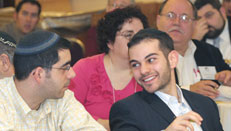 |
||||||||||||
| Weekly Parsha | ||
| Current Week | ||
| Parsha Archives | ||
| Business Ethics | ||
| Dr. Malamet Speaks Out | ||
| TiM MP3 Library | ||




A Thought for the Week with Rabbi Jay Kelman
|
 "You shall dwell in booths for seven days... so that future generations will know that I caused the children of Israel to dwell in booths when I took them from the land of Egypt"(Vayikra 23:42-43). The Rabbis of the Talmud (Sukkah 11b) debate whether our Sukkot commemorate the actual booths the Jews lived in during their sojourn in the desert, or whether the Sukkah is meant to represent the anannei hakavod (clouds of glory) that directed and protected the Jewish people during their circuitous march to the land of Israel. Interestingly enough, the accepted ruling is that our Sukkot are a commemoration of the anannei hakavod . Thus, when we dwell in the Sukkah, we must keep in mind not so much the flimsy huts we lived in, but the protecting and guiding hand of Hashem. It appears that the connection between the anannei hakavod and Sukkot functions not only on a historical level but on a philosophical one as well. The Siddur Otzar Hatefillot quotes a teaching in the name of the Vilna Gaon that upon the sin of the golden calf, the clouds of glory disappeared. They did not make their reappearance until construction began on the mishkan, which coincided with the holiday of Sukkot. Our Rabbis (Taanit 9a) teach that it was through the merit of our three leaders that the Jews were able to survive in the desert. In the merit of Moshe we received our manna bread; we had water due to the merit of Miriam; and it was in Aharon's honour that the Jewish people were guarded by the anannei hakavod . By giving us the Torah, Moshe Rabbeinu, the teacher par excellence, gave us our sustenance, our 'bread and butter'. Had Miriam not pleaded with her parents to have additional children even in the face of slavery, there would be no Judaism; we would have ceased to exist, then and there. Hence water, the most precious and necessary of all resources, was given to us in her merit. What though is the connection between the clouds of glory and Aharon? Aharon is known in rabbinic literature as the ohev shalom v'rodef shalom , the lover of peace and pursuer of peace. It was the clouds of glory that allowed us to live in peace. According to the Midrash, the bows and arrows that the Egyptians directed at us at the sea were deflected by these clouds (Rashi, Shemot 14:19). "The king of Arad heard that Israel had come and he attacked them" (Bamidbar 21:1). Our sages tell us he heard that Aharon had died and that the clouds of glory had departed, hence, the Jews were vulnerable. Sukkot is the holiday of peace. "And spread over us the Sukkah of compassion, life and peace" (Maariv prayer service). External peace, though, is dependent on internal peace. Thus, it follows that Sukkot is also the holiday of Jewish unity. The four species of the lulav represent the various types of Jews, ranging from the most meticulously observant to the least so. Yet all must be present in order to have a kosher lulav . Aharon was also the high priest in the Temple , a Temple which depended on internal unity in order to stand. With the command to construct the Mishkan and bring internal harmony to the Jewish people, the clouds of glory were set to reappear. Not coincidentally the actual construction began on Sukkot, the holiday of Jewish unity. When we sit in the sukkah we must remember the message of the anannei hakavod , that we must dwell internally at peace. This is the way to assure that G-d will protect us under His tabernacle of peace.! |
|
|

 |
 |